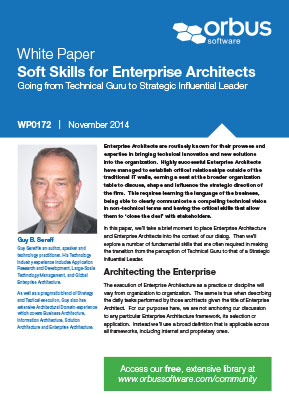Guy Sereff talks about the skills and languages architects need to learn in order to earn a seat at the broader organization table outside of the traditional IT walls.
Enterprise Architects are routinely known for their prowess and expertise in bringing technical innovation and new solutions into the organization. Highly successful Enterprise Architects have managed to establish critical relationships outside of the traditional IT walls, earning a seat at the broader organization table to discuss, shape and influence the strategic direction of the firm. This requires learning the language of the business, being able to clearly communicate a compelling technical vision in non-technical terms and having the critical skills that allow them to ‘close the deal’ with stakeholders.
Architecting the Enterprise
The execution of Enterprise Architecture as a practice or discipline will vary from organization to organization. The same is true when describing the daily tasks performed by those architects given the title of Enterprise Architect. For our purposes here, we are not anchoring our discussion to any particular Enterprise Architecture framework, its selection or application. Instead we’ll use a broad definition that is applicable across all frameworks, including internal and proprietary ones.
In this paper, we’ll take a brief moment to place Enterprise Architecture and Enterprise Architects into the context of our dialog. Then we’ll explore a number of fundamental skills that are often required in making the transition from the perception of Technical Guru to that of a Strategic Influential Leader.
Sign in to continue reading about the soft skills needed for enterprise architects.
